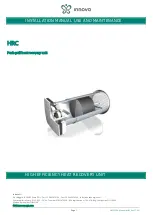
42
GB/NI/IE
Using the device
Welding mask
HEALTH HAZARD!
If you do not use the welding mask, harmful
UV radiation and heat emitted by the electric
arc could damage your eyes.
Always use the welding mask for welding
work.
z
Welding
RISK OF BURNS!
Welded workpieces are very hot and can
cause burns.
Always use pliers to move hot, welded
workpieces.
Please proceed as follows once
you have electrically connected the
welding device:
Connect the earth cable to
4
the
workpiece that is to be welded using
the earth terminal. Please ensure good
electrical conductivity.
The area to be welded on the workpiece
must be free of rust and paint.
Choose the desired welding current and
wire feed depending on the welding
wire diameter, material thickness and
desired penetration depth.
Switching the device on.
Hold the welding mask
20
in front of
your face and guide the torch nozzle
7
to the position on the workpiece that is to
be welded.
Press the torch button
12
, in order to
generate an arc. Once the electric arc is
burning, the device feeds wire into the
weld pool.
If the welding lens is big enough, the
torch
11
is slowly guided along the
desired edge. The distance between the
torch nozzle and workpiece should be as
small as possible (it must not be greater
than 10 mm).
If necessary, oscillate a little to increase
the size of the weld pool. For inexperi-
enced welders, it is often difficult initially
to create a decent electric arc. To do so,
the welding current and wire feed rate
must be set correctly.
You can work out the ideal settings for
the welding current and the wire feed
rate by carrying out trial welds on a test
piece. A properly set electric arc has a
mild, uniform buzzing sound.
The penetration depth (corresponds to
the depth of the welding seam in the
material) should be as deep as possible
without allowing the welding pool to fall
through the workpiece.
Reduce the wire feed rate in case of a
rough or hard rattle or switch to a higher
power level (increase welding current).
If the wire feed rate is too high and/or
the welding current too low, the welding
wire will not melt properly. Consequently,
the welding wire repeatedly dips in the
welding pool as far as the workpiece.
A quiet, muffled sound with a flickering
electric arc indicates the wire feed is
too low.
Increase the wire feed rate or switch to
a lower welding current. If the welding
current is too high, the wire will melt
before it even reaches the weld bed.
This results in droplet formation on the
welding wire as well as splash and an
irregular electric arc.
The slag can only be removed from
the seam once it has cooled down.
To continue welding an an interrupted
seam:
First remove the slag at the starting point.
The electric arc is ignited in the weld
groove, guided to the continuation point,
melted properly and finally the weld
seam is continued.
CAUTION:
Please note that the torch
must always has to be placed on down
an insulated surface after welding.
Always switch off the welding device
after completing welding work and
during breaks and pull the plug from
the mains socket.
Summary of Contents for 306962
Page 3: ...19 18 14 15 17 17b 1 29 2 13 12 11 10 9 8 3 4 5 6 7 ...
Page 4: ...A1 B A2 24 23 16 22 20 21 30 33 28 27 ...
Page 47: ...47 GB NI IE ...
Page 48: ...48 GB NI IE ...
Page 72: ...72 FR BE Notes ...
Page 94: ...94 NL BE Notities ...
Page 117: ...117 ES Índice ...
Page 118: ...118 ES ...
Page 139: ...139 CZ ...
Page 140: ...140 CZ ...
















































